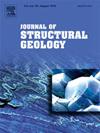Hydrogeological implications of fault-related folding in a Triassic braided sandstone
IF 2.9
2区 地球科学
Q2 GEOSCIENCES, MULTIDISCIPLINARY
引用次数: 0
Abstract
Although our understanding of how fault-related folds influence groundwater flow has advanced, the understanding of the exact geometries and architecture of displacement propagation is often uncertain. This paper focuses on fault-related folds (i.e., fault bend, fault propagation, and detachment folding) within a braided sandstone and their implications for groundwater flow due to the internal fracture architecture. To achieve this, we combine lineament mapping, field observations, 3D regional kinematic geological restoration modelling, and juxtaposition analysis of a major aquifer system in the Permo-Triassic Sydney Basin. Our lineament mapping allowed for targeted fieldwork where outcrop observations unveiled a mechanical stratigraphy (i.e. variations in mechanical properties, layer thickness, and frictional properties of mechanical boundaries) controlled by the braided river depositional architecture. This results in systematically spaced fracture sets and rotational shearing following the sedimentary fine-grained depositional variations causing brittle folding of the sandstone mass. Our 3D geological modelling quantitated the existence of regional fault-related fold geometries. We re-interpret these folded zones as broad fault damage zones, which are likely to promote vertical fracture flow through a rock matrix otherwise dominated by horizontal porous flow controlled by the depositional braided river environment. The conceptual model for potential for flow within the folded sandstone is then placed into the regional study context by fault juxtaposition analysis of displacements across the major regional aquifers separated by a regional aquitard assuming the geometry of a fault propagation fold. Such insights were notably absent from previous conceptual groundwater models for fault-related folds in braided river deposited sandstone successions. Our findings enhance the understanding of how mechanical stratigraphy can strongly influence the internal structures of fault-related folds and, in turn, affect the groundwater system connectivity.
三叠系辫状砂岩断层相关褶皱的水文地质意义
虽然我们对断层相关褶皱如何影响地下水流动的理解已经取得进展,但对位移传播的精确几何形状和结构的理解往往是不确定的。本文重点研究了辫状砂岩中与断层相关的褶皱(即断层弯曲、断层扩展和滑脱褶皱)及其内部断裂结构对地下水流动的影响。为了实现这一目标,我们结合了线条测绘、现场观测、3D区域运动学地质恢复模型,以及对悉尼盆地二叠纪-三叠纪主要含水层系统的并置分析。我们的地貌测绘允许有针对性的野外工作,在野外,露头观测揭示了由辫状河沉积结构控制的机械地层学(即机械特性、层厚和机械边界摩擦特性的变化)。这导致了系统间隔的裂缝集和随着沉积细粒沉积变化的旋转剪切,导致砂岩体的脆性褶皱。我们的三维地质建模量化了区域断层相关褶皱几何形状的存在。我们将这些褶皱带重新解释为宽断裂破坏带,它们可能促进岩石基质中的垂直断裂流动,否则由沉积辫状河环境控制的水平多孔流动占主导地位。然后,通过断层并置分析,通过假定断层传播褶皱的几何形状,对由区域含水层分隔的主要区域含水层进行位移分析,将褶皱砂岩内部流动潜力的概念模型置于区域研究背景中。这种见解在以前的关于辫状河沉积砂岩层序中断层相关褶皱的概念性地下水模型中是明显缺失的。我们的发现增强了对机械地层学如何强烈影响断层相关褶皱内部结构的理解,进而影响地下水系统的连通性。
本文章由计算机程序翻译,如有差异,请以英文原文为准。
求助全文
约1分钟内获得全文
求助全文
来源期刊

Journal of Structural Geology
地学-地球科学综合
CiteScore
6.00
自引率
19.40%
发文量
192
审稿时长
15.7 weeks
期刊介绍:
The Journal of Structural Geology publishes process-oriented investigations about structural geology using appropriate combinations of analog and digital field data, seismic reflection data, satellite-derived data, geometric analysis, kinematic analysis, laboratory experiments, computer visualizations, and analogue or numerical modelling on all scales. Contributions are encouraged to draw perspectives from rheology, rock mechanics, geophysics,metamorphism, sedimentology, petroleum geology, economic geology, geodynamics, planetary geology, tectonics and neotectonics to provide a more powerful understanding of deformation processes and systems. Given the visual nature of the discipline, supplementary materials that portray the data and analysis in 3-D or quasi 3-D manners, including the use of videos, and/or graphical abstracts can significantly strengthen the impact of contributions.
 求助内容:
求助内容: 应助结果提醒方式:
应助结果提醒方式:


